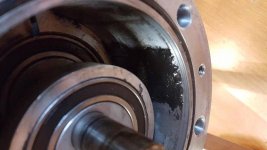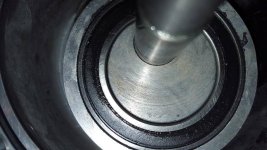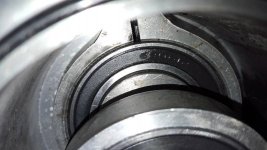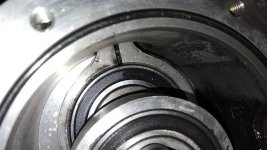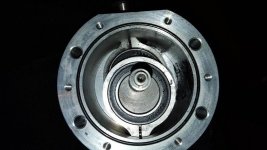Okay so I've ran just under 10 lbs of distilled liquid butane through my pump now and recovered 150lbs+ through it as well. Doing a dry run with it left behind a small amount of oil and the same strong grease/lubrication smell as it did a few months ago when I tried using it. Is there anything I can actually do about it? If I strip it down to nothing, will I indeed be able to solve the issue? Anyone know? I also burp out the lines with gas and do not run in a vacuum. Idk what to do at this point other than take it apart. I've also recontaminated my whole system again thanks to it.
You are using an out of date browser. It may not display this or other websites correctly.
You should upgrade or use an alternative browser.
You should upgrade or use an alternative browser.
Need advice on CMEP-OL clean out.
- Thread starter jswick93
- Start date
I don't think you'll get the stink out without tearing it down. It should have washed out by now unless it isn't butane soluble.
At least if you tear it apart you can pinpoint the source. If it's highly viscous and not very soluble in butane you are going to have to tear it apart to clean it out anyway. Take the heads of and see if it may be piston seals dissolving.
Chinese polymer science has a ways to go yet...
RB
At least if you tear it apart you can pinpoint the source. If it's highly viscous and not very soluble in butane you are going to have to tear it apart to clean it out anyway. Take the heads of and see if it may be piston seals dissolving.
Chinese polymer science has a ways to go yet...
RB
Pure777Extracts
Member
Take it apart, its not that complicated to at least look inside, I went to BHOgart to have mine repaired because my pump started getting loud like something was off and the week before had to run with no molecular sieve, which I knew would mess up the pump but I had no choice. They told me no more warranty but 100hr and I could watch, so we took it apart, and I was actually surprised how clean it was and so was he, the problems were my bearing needed either replacement or lube but we cleaned all parts and used food grade lube on bearings, I wouldn't recommend doing the bearing yourself as he had special tools he made to remove them and had a trick for centering them as well but I can post the pics I have later but I recommend taking it to BHOgart and have them help you out. Make sure you clean your pump out still because the guy would lube the compression fittings and didn't really care if some got inside and I had to remind him we make medicine with these.(he was a mechanic or is in training, I cant remember) But I was glad I was there to clean it off before he put the fittings together and I still flushed the pump when I got back to lab. They also replaced all the seals, and its working great. I still run filter post pump, but was very happy with internals when compared to the TR21.
Last edited:
Pure777Extracts
Member
This post was supposed to have pics but its not working and I dont know whats wrong, never had problems before, but Ive tried every way I know.
http://i166.photobucket.com/albums/u114/pure777extracts/IMG_9647_zpsmbkomotd.jpeg
http://i166.photobucket.com/albums/u114/pure777extracts/IMG_4121_zpsobpxlqoq.jpeg
http://i166.photobucket.com/albums/u114/pure777extracts/IMG_3063_zpsinzcha5v.jpeg
http://i166.photobucket.com/albums/u114/pure777extracts/IMG_2153_zpsxbiumfvx.jpeg
http://i166.photobucket.com/albums/u114/pure777extracts/IMG_9647_zpsmbkomotd.jpeg
http://i166.photobucket.com/albums/u114/pure777extracts/IMG_4121_zpsobpxlqoq.jpeg
http://i166.photobucket.com/albums/u114/pure777extracts/IMG_3063_zpsinzcha5v.jpeg
http://i166.photobucket.com/albums/u114/pure777extracts/IMG_2153_zpsxbiumfvx.jpeg
Last edited:
Maybe we can exchange those pictures outside of here if you can't get them to post. Im sure they'd be helpful. There is a Bhogart opening up near me next month supposedly. Hopefully if I can't figure it out or I have issues later on they will be able to help me with it. There isn't anything I shouldn't undo is there? The bearings are safe where they are correct?
Pure777Extracts
Member
Maybe we can exchange those pictures outside of here if you can't get them to post. Im sure they'd be helpful. There is a Bhogart opening up near me next month supposedly. Hopefully if I can't figure it out or I have issues later on they will be able to help me with it. There isn't anything I shouldn't undo is there? The bearings are safe where they are correct?
yea no prob my email is [email protected] , you shouldn't have to break it down that far, but after seeing the internals I think just flushing it should clean it, the only thing I keep thinking is they definitely use something to lubricate those cheap compression fitting and get them to actually tighten. I smelled it when I first bought my pump but cleaned the outside with soap and water and flushed it with like 3-5lbs of distilled tane. Never run it dry or under vacuum.
Concentrated_
New member
I would like to see those pics as well, I have one going to bhogart San Jose to have the bearings fixed after 25 hours or so,and when you say under vacuum do you mean dry, I know it sounds Like a dumb question but I'm just trying to get back up and running I've never had these problems with any other pumps if passive was an option after this last week I would be switching
yea no prob my email is [email protected] , you shouldn't have to break it down that far, but after seeing the internals I think just flushing it should clean it, the only thing I keep thinking is they definitely use something to lubricate those cheap compression fitting and get them to actually tighten. I smelled it when I first bought my pump but cleaned the outside with soap and water and flushed it with like 3-5lbs of distilled tane. Never run it dry or under vacuum.
I sent you an email. Thank you.
...I have one going to bhogart San Jose to have the bearings fixed after 25 hours or so...
That made me think that maybe the crankcase is sealed on these pumps.
If the crankcase is not vented small amounts of butane that get past the piston seal can wash out grease from the bearings where it will likely find its way Back into the top of the piston due to pressure swings.
This is why the older Promax Rg units are bad for this application.
This is a significant design flaw.
Anyone have pictures of the crankshaft/ crankcase on the CMEP-OL?
I might have one of these to evaluate soon so I'll report back.
The bearings should last a long time. If they do replace them, make sure they are not from the factory but quality bearings with decent seals.
Peace
RB
Pure777Extracts
Member
I would like to see those pics as well, I have one going to bhogart San Jose to have the bearings fixed after 25 hours or so,and when you say under vacuum do you mean dry, I know it sounds Like a dumb question but I'm just trying to get back up and running I've never had these problems with any other pumps if passive was an option after this last week I would be switching
25 wow... that is odd. Yes never under vacuum or dry. I leak test with pressure, and do not vacuum out oxygen to operate. I push it out with bleed valve on output right before solvent tank. I heard about the possibility of grease getting making it way past the bad seal design so I just never wanted to have it under vacuum to avoid that completely, and never run dry or below 0 for the seals to last longer.
That made me think that maybe the crankcase is sealed on these pumps.
If the crankcase is not vented small amounts of butane that get past the piston seal can wash out grease from the bearings where it will likely find its way Back into the top of the piston due to pressure swings.
This is why the older Promax Rg units are bad for this application.
This is a significant design flaw.
Anyone have pictures of the crankshaft/ crankcase on the CMEP-OL?
I might have one of these to evaluate soon so I'll report back.
The bearings should last a long time. If they do replace them, make sure they are not from the factory but quality bearings with decent seals.
Peace
RB
I have the pics but cant figure out why its not uploading. I think you are correct although I don't think it can really make its way back up. It looked splattered around the crankcase but looks like it wont go back up, and It technically good have been bho that was splattered around the walls, but I could not tell? If I can get your email I can send them to you.
I think you are correct although I don't think it can really make its way back up. It looked splattered around the crankcase but looks like it wont go back up, and It technically good have been bho that was splattered around the walls, but I could not tell?
The splattered around the crankcase comment makes me more certain that's where the stinky is coming from.
The CMEP-OL uses an inverted cup seal if I recall. I've seen a pic but can't locate it.
Anyway, the cup seal is good for sealing in one direction only. any accumulation of oil or grease on the cylinder walls will get pushed back into the area above the piston.
What I think is happening is this: small amounts of butane are leaking past the piston seal and pressurizing the crankcase. Some butane can also permeate the bearings and dissolve into the grease under pressure.
When that pressure is released either at the end of recovery or when the pump is shut off the butane will boil out of the grease and drive some of it past the bearing seals.
When that happens, even if its a tiny amount every run it'll get splattered onto the cylinder walls. Next time it's run the crankcase gets pressurized and if that pressure gets higher than the pressure on top of the piston the grease will migrate upward.
This may also explain why they are not recommended for vacuum.
Disclaimer: this is my own speculation at this point. If anyone in the Vancouver area has one of these I'd like to look at it.
It's also an easy modification to overcome the issue.
Peace,
RB
Concentrated_
New member
It sounded like some thing just wasn't perfectly balanced and had gotten progresively worse, beating is what the rebuild guy at bhogart thought. He said they don't like sitting under vac overnight but I never do that, I bleed the system at the end of each night. I like your bleed valve idea I already have one to recover the butane from the pump. Is there any way you could send a pic of your setup I can't quite picture it.
I'm not 100% sure on how to get this part detached from the blue motor. I'd like to clean it all out. I'm not sure whether or not the bearings are at fault. But that's a lot of shit in there. Isn't it more likely its there from the manufacturing? There's doesn't seem to be bunches of grease coming out from the seals over the bearings, just the same amount that coats all of the internals.
Pure777Extracts
Member
wow thats how mine looked after months and maybe not that bad, and Ricky I think you are correct, but the bottom half of piston wall was spotless and top had all the gunk. Can you dm your email and Ill send you the pics.
wow thats how mine looked after months and maybe not that bad, and Ricky I think you are correct, but the bottom half of piston wall was spotless and top had all the gunk. Can you dm your email and Ill send you the pics.
Was yours determined to be grease from the pump? If so, I'm curious how you avoided getting this into your butane stream? Mine has pretty few hours of use, less than 20 and has never seen an extraction. I know mine is pump gunk. It's hard to believe all that would have came from the bearings, and it does seem that the bearings are sealed off underneath those gaskets and not vented.
There's a couple more pictures here, and it looks as if either there is lubricant either seeping through the inner part of the gasket, or just getting caught in there from the outside. I'm not sure how to best clean this out. I managed to get the compressor off the motor. It looks like there a small bolt which adds compressiom around the gasket on each piston. That's just how it looks to be, and if that's the case, It's possible it's not perfect. But still a lot of junk to have come from there in my opinion. The pump has only ran an hour or so since I ran all that liquid butane through it. I'm imagining it isn't very butane soluble.
Keeping in mind the bearing lubrication, should I just clean everything else first, then maybe have a peek under those gaskets? If contamination from the bearings was an issue though I feel like more people would be having issues. If they're on correctly, shouldn't they be sealed off well enough to not allow anything to come out?
Attachments
...The pump has only ran an hour or so since I ran all that liquid butane through it. I'm imagining it isn't very butane soluble.
Keeping in mind the bearing lubrication, should I just clean everything else first, then maybe have a peek under those gaskets? If contamination from the bearings was an issue though I feel like more people would be having issues. If they're on correctly, shouldn't they be sealed off well enough to not allow anything to come out?
Hooo boy. Houston we've got a fucking problem.
Thanks for the pix jswick, I'm pretty certain what's going on now. (the grease is very soluble in butane btw.)
There's a serious design flaw with these units.
Pure777: I only just now saw the photobucket links, sorry I didn't see them earlier.
The goop y'all are finding is coming from the crankshaft bearings and essentially can't be stopped without modifying the pump.
I think there's a couple of mechanisms that push the grease out of the bearings. It's hard to explain so I'll try to make it clearer this time.
These look like standard 6008RS bearings. (I think that's the number I see) The seals are designed to keep the grease in but they are not gas tight. When running, butane under pressure will get past the seals and dissolve into the grease inside of the bearing.
This will thin out the grease to a thin enough viscosity that can then weep past the seals.
The other mechanism is the butane boiling out of the grease. When the pump is shut off and vented, any butane dissolved in the grease will start to boil out.
You've all seen this happen with butane boiling out of your extracts. When the butane starts to purge out of the grease it will create gas pressure within the bearing and push the grease out past the seals.
The first pic jswick posted has a puddle of grease on the bottom of the housing. This can still find its way onto the piston walls. When running it'll get thinned out with butane and heat and the windage created in the housing will move it around.
The first pic Pure777 posted shows the bearing seal completely failed.
Why would they design it this way? Likely in a misguided attempt to make it explosion proof. Seal everything up.
Unfortunately they forgot to take a few things into consideration...
Why are some people finding grease more than others? Probably just due to sloppy manufacturing tolerances and the fact that not every pump is being run the same way.
What to do?
Well.... that's not easy. Just cleaning the grease out and replacing the bearings won't help. Some may have experienced longer run times between failures and less grease in the system after rebuilding with better bearings.
Even if they don't fail small amounts of grease will migrate into the butane stream over time.
Venting the crankcase is the only possible solution I can see at this point. And not something a non-machinist can do easily.
Ideally it should be plumbed to a line that can be vented outside or into an external tank.
Band aid solution would be to put a mol sieve between the compressor outlet and the heat exchanger or at lease on the heat exchanger / condenser outlet on the outside of the compressor.
If someone can get one into my hands I'll modify it and make a tutorial on how to do it.
RB
Pure777Extracts
Member
I did not inspect it that much because I didn't think anything was getting past the seals, and like I said I had no filter or molecular sieve on input for about a week so expected it to be gunked up on that side of piston walls. I have a 1/2" sporlan HH filter on output of pump at all times. That filter has activated charcoal in it. Suppose to clean gas after pump failure.
Damn yea that might be whats happening RB, I figured the way I run the pump and filter were making it safe, also talked with SC labs after few test results and they said the pump was not contaminating anything but not sure if I can trust that. I hope you get one!
Damn yea that might be whats happening RB, I figured the way I run the pump and filter were making it safe, also talked with SC labs after few test results and they said the pump was not contaminating anything but not sure if I can trust that. I hope you get one!
RB you pretty much nailed it! The cmep-ol is very poorly designed for our application. I have already replaced the bearings on mine and scrapped the instrument valves and heat exchanger and vented the crankcase as a bandaid until a more suitable pump gets here.
I feel like ignorance is bliss when it comes to operating these machines...that's why most people don't think they're having any issues. Fyi I use a 3x24" column as a multi-stage vapor filter as well as 24" high collection pots so ingesting oil is a non-issue here. I have two 3x24" columns for liquid phase filtration on either side of my solvent tank.
If you don't run your cmep-ol into vacuum whatsoever, chances are you will only have to deal with normal wear of the piston seals (looking closely they appear to be a ptfe and graphite or moly composite) causing small particulates to enter your solvent. But once your piston seals start to wear, solvent vapor will pressurize the crankcase, dissolve the rod bearing lube and centrifugal forces will sling lubricant out towards the pistons, and then everything goes downhill from there (keep reading). The bearing seals do nothing to hold in the lubricant. If you recover into a vacuum at all, whether it be to pour out, muffin tech, or to recover the solvent from your column...whatever. To varying degrees, you will be pulling the rod bearing lubricant into the crankcase, past the piston seals and into your solvent. The bulk of this lubricant will be deposited in your heads, through the exhaust plumbing and into the heat exchanger. But to a lesser extent it will also get into your hoses, aftercooler, and supply tank, requiring one heck of a clean out if you care about what you do. The cup seals on this piston design just aren't suited to our application. Once the cylinders are contaminated, wear of both the piston seals and cylinder walls can happen rather quickly. Interestingly enough, in the cold I took one of my heads outside and attempted to clean the contamination with a butane soaked rag. The black stuff didn't dissolve nearly as easily as it did with 99% iso, which didn't make me feel confident trusting the butane flush out method that others have used. I scrapped everything downstream of the heads and started over.
The rod bearings are 6908-RS, the inboard shaft bearing is 6004RZ and the outboard bearing is 6203RZ. I am experimenting with a set of full-complement ceramic bearings that are supposed to be able to be run dry without lubricant, which could eliminate that source of contamination. But with the piston seal design on this pump, I don't plan on running it any longer than I have to.
Good luck everybody. Obviously don't do anything I talk about unless you are willing to accept responsibility for your own actions.
I feel like ignorance is bliss when it comes to operating these machines...that's why most people don't think they're having any issues. Fyi I use a 3x24" column as a multi-stage vapor filter as well as 24" high collection pots so ingesting oil is a non-issue here. I have two 3x24" columns for liquid phase filtration on either side of my solvent tank.
If you don't run your cmep-ol into vacuum whatsoever, chances are you will only have to deal with normal wear of the piston seals (looking closely they appear to be a ptfe and graphite or moly composite) causing small particulates to enter your solvent. But once your piston seals start to wear, solvent vapor will pressurize the crankcase, dissolve the rod bearing lube and centrifugal forces will sling lubricant out towards the pistons, and then everything goes downhill from there (keep reading). The bearing seals do nothing to hold in the lubricant. If you recover into a vacuum at all, whether it be to pour out, muffin tech, or to recover the solvent from your column...whatever. To varying degrees, you will be pulling the rod bearing lubricant into the crankcase, past the piston seals and into your solvent. The bulk of this lubricant will be deposited in your heads, through the exhaust plumbing and into the heat exchanger. But to a lesser extent it will also get into your hoses, aftercooler, and supply tank, requiring one heck of a clean out if you care about what you do. The cup seals on this piston design just aren't suited to our application. Once the cylinders are contaminated, wear of both the piston seals and cylinder walls can happen rather quickly. Interestingly enough, in the cold I took one of my heads outside and attempted to clean the contamination with a butane soaked rag. The black stuff didn't dissolve nearly as easily as it did with 99% iso, which didn't make me feel confident trusting the butane flush out method that others have used. I scrapped everything downstream of the heads and started over.
The rod bearings are 6908-RS, the inboard shaft bearing is 6004RZ and the outboard bearing is 6203RZ. I am experimenting with a set of full-complement ceramic bearings that are supposed to be able to be run dry without lubricant, which could eliminate that source of contamination. But with the piston seal design on this pump, I don't plan on running it any longer than I have to.
Good luck everybody. Obviously don't do anything I talk about unless you are willing to accept responsibility for your own actions.
Ripcity said:The black stuff didn't dissolve nearly as easily as it did with 99% iso, which didn't make me feel confident trusting the butane flush out method that others have used. I scrapped everything downstream of the heads and started over.
A very good point about the nonpolar flushes. I think many-a-teardowns are in session. I vow to have pictures up in reasonable time..

